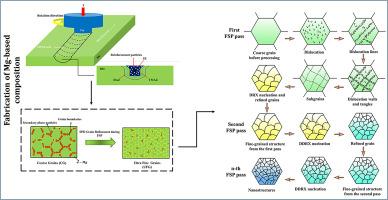A comprehensive review of microstructure and mechanical properties of friction stir processed magnesium alloys and composites
IF 13.8
1区 材料科学
Q1 METALLURGY & METALLURGICAL ENGINEERING
引用次数: 0
Abstract
Friction stir processing (FSP) induces severe plastic deformation, generating intense strains and localized heating, which modifies the surface and enables the fabrication of magnesium (Mg)-based composites. This technique refines the microstructure of Mg alloys, enhancing mechanical properties—particularly ductility, a key limitation of these HCP alloys. This review addresses the underlying microstructural evolution during FSP of Mg alloys and Mg-matrix composites, including (i) grain refinement via continuous and discontinuous dynamic recrystallization (CDRX and DDRX), (ii) fragmentation and redistribution of secondary phases and intermetallics, (iii) transformation of low- and high-angle grain boundaries, and (iv) additional microstructural changes induced by external reinforcements. This review provides a comprehensive analysis of the strengthening mechanisms and their impact on the mechanical properties of FSP Mg alloys and Mg-matrix composites (MMCs). The paper examines the correlation between FSP processing parameters, microstructural evolution, and resulting mechanical properties. It critically highlights how the type of reinforcement and the dynamic recrystallization induced by friction stir processing influence grain boundary character and, consequently, the material’s strengthening response. It includes a comparative evaluation of yield stress, ultimate tensile strength, microhardness, elongation, and fractography for various FSP-treated Mg alloys and MMCs, including AZxx, WExx, ZExx, ZKxx, AMxx, AExx, and Mg-rare earth alloys. Additionally, the novelty of this review lies in its emphasis on connecting microstructural transformations to mechanical performance trends across different alloy systems and processing strategies, an aspect that has been underexplored in previous reviews. Recent advancements in FSP techniques and their implications for improving the performance of Mg-based materials are also discussed.

搅拌摩擦镁合金及其复合材料的显微组织和力学性能综述
搅拌摩擦加工(FSP)引起严重的塑性变形,产生强烈的应变和局部加热,从而改变表面,使镁基复合材料的制造成为可能。该技术细化了镁合金的微观结构,提高了机械性能,特别是延展性,这是这些HCP合金的一个关键限制。本文综述了镁合金和镁基复合材料在FSP过程中潜在的组织演变,包括(i)通过连续和不连续动态再结晶(CDRX和DDRX)进行的晶粒细化,(ii)二次相和金属间化合物的破碎和再分布,(iii)低角度和高角度晶界的转变,以及(iv)外部增强引起的额外组织变化。本文综述了FSP镁合金和镁基复合材料的强化机理及其对力学性能的影响。本文研究了FSP加工参数、微观组织演变和由此产生的力学性能之间的关系。它重点强调了强化类型和搅拌摩擦处理引起的动态再结晶如何影响晶界特性,从而影响材料的强化响应。它包括对各种fsp处理的镁合金和mmc(包括AZxx, WExx, ZExx, ZKxx, AMxx, AExx和Mg-稀土合金)的屈服应力,极限抗拉强度,显微硬度,伸长率和断口学的比较评估。此外,这篇综述的新颖之处在于它强调了将微观组织转变与不同合金系统和加工策略的机械性能趋势联系起来,这是以往综述中未充分探讨的一个方面。本文还讨论了FSP技术的最新进展及其对改善镁基材料性能的影响。
本文章由计算机程序翻译,如有差异,请以英文原文为准。
求助全文
约1分钟内获得全文
求助全文
来源期刊

Journal of Magnesium and Alloys
Engineering-Mechanics of Materials
CiteScore
20.20
自引率
14.80%
发文量
52
审稿时长
59 days
期刊介绍:
The Journal of Magnesium and Alloys serves as a global platform for both theoretical and experimental studies in magnesium science and engineering. It welcomes submissions investigating various scientific and engineering factors impacting the metallurgy, processing, microstructure, properties, and applications of magnesium and alloys. The journal covers all aspects of magnesium and alloy research, including raw materials, alloy casting, extrusion and deformation, corrosion and surface treatment, joining and machining, simulation and modeling, microstructure evolution and mechanical properties, new alloy development, magnesium-based composites, bio-materials and energy materials, applications, and recycling.
 求助内容:
求助内容: 应助结果提醒方式:
应助结果提醒方式:


